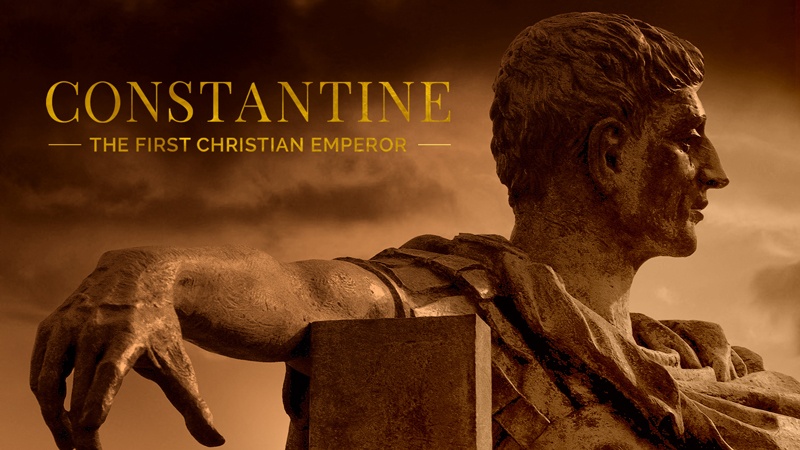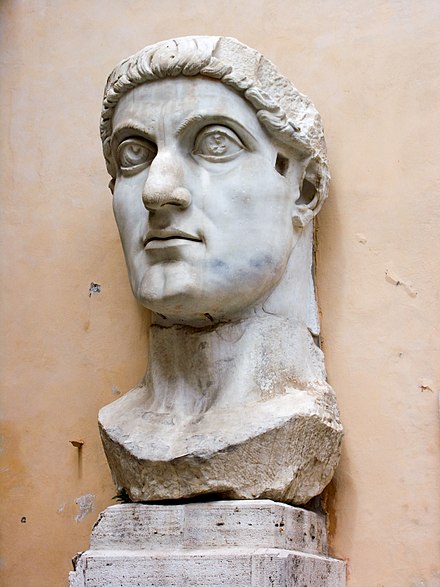Constantine’s life spans from 280-337 AD. He became caesar in the contentious year of 311. (Contention was the normative state with most of this latter part of Roman history.) All calculated Rome was a world power for at least 1,500 years, and even more if we count the years as a republic, from 509 to 49 BC, when the republic transformed into an empire under the elevation of Julius Caesar to dictator. When we fast forward to Constantine, the Western Empire has a little more than 100 years to survive before the Germanic tribes dismantle it. It’s the Eastern Empire, the one that Constantine firmly established in Constantinople (Istanbul today) that would last until 1458.
Constantine The Great: The First Christian Emperor
Setting the Stage to Become Emperor
As you might suspect, Constantine is made heir presumptive through heredity, being that his father Constantius, is appointed to the role of caesar of the Eastern Empire by Diocletian. If we leave it at that, it sounds like an easy enough transition. However, if you know the name of Diocletian, you will know that this is not an easy time, especially for a newly founded religion called Christianity, but that’s getting ahead of our story.
The Empire had become unwieldy in its constant expansion, and in an effort to more tightly control various provinces, Diocletian made Maximian co-emperor to rule the West, while he would rule the East. Eight years later, in 293 AD, he divides the Empire into two additional parts. That’s where Constantius, Constantine’s father, enters into leadership as caesar along with Galerius. Here’s what happens next: Constantius dies, Maximian tries to kill Constantine early on and then Maxentius, Maximian’s son, stages a civil war in Rome before dying in 312, just a year after his father, Galerius dies of bowel cancer the same year, and Diocletian goes into retirement, dying in 312. With the deaths of all these opponents, Constantine becomes the undisputed emperor.
Christianity: Persecuted, Then Accepted
The story of Christianity’s rise to prominence is weaved throughout this time period, first with persecution and then in formal adoption by Rome. As you know, Christians were persecuted earlier by Roman Emperors Nero (37-68) and Domitian (51-96), to name two noteworthy scoundrels, and Diocletian took on a similar distaste and distrust of Christians. In one account, Diocletian orders the tongue of Romanus of Caesarea, a Christian deacon from Palestine, to be cut out due to his protest of sacrifices to Roman gods. He is then further tortured and finally strangled. While Diocletian resolves later to simply allow Christians to exclude themselves from various state activity (because they weren’t cooperating even under persecution), Galerius advocates for full extermination. Galerius wins the argument and full-on persecution begins. The order was not simply for Christians themselves to be arrested and punished (or killed), but that churches and scriptures be destroyed. In the end, the plan was unsuccessful, both because of the resilience of the Christians and the unsympathetic view of normal citizens of the Empire toward these decrees. What resulted was the first step for Christianity’s acceptance across the Roman world. Galerius issued an edict of tolerance toward Christians in 311, the same year he dies.
As Constantine comes to the throne, Christianity is beginning to leave the catacombs that had defined its early years. The government begins to offer its help, officially adopting it in 380 AD, in part due to the powerful witness of Constantine, the first Christian emperor of Rome. How Constantine adopts his faith is the stuff of lore.
Constantine Battles for Dominance
In 312, before claiming anything that approaches emperor-status, Constantine is forced to battle Maxentius, who declares civil war on Constantine in part because he think his father is murdered (he wasn’t) and in part because he has every strategic advantage to succeed. Maxentius forges key alliances, retains the allegiance of the Roman guard, and possesses Rome and northern Italy. But this is all before Constantine sees a cross. The historian Eusebius says that as Constantine approaches Rome, after decisive wins in the north, he sees a cross in the sky with the message, “with this sign, you shall win.” That night, Constantine also falls into a dream where Christ says to make the chi and rho, the first two letters of Christ, as the banner he takes into battle.
The battle the ensues for Rome is brief. Maxentius dies, drowning in the Tiber River when Constantine’s calvary charges into the city. After Constantine enters the city, Maxentius’s body is fished out of the river and his head is paraded through the city. He is victor, but unlike victors in the past, Constantine does not offer sacrifices to the gods. Though his faith is far from solid, this is a starting point, and in 313, he takes another step, issuing the Edict of Milan which grants tolerance toward Christianity throughout the empire.
The Establishment of Constantinople
In the few years following the defeat of Maxentius, Constantine must defeat further rebellions to keep power, putting back a one emperor rule in opposition to the divisions that Diocletian made. You can imagine that with these divisions of power, like Maxentius and Constantine, other sons of the fathers who Diocletian appointed, want to stake their own claim. However, Constantine is successful in gaining power and he then shifts to securing it. One of his primary and lasting legacies is moving the capital the the east, making Constantinople the empire’s supreme city. The new capital helps to bring together the interests of the east and west, and to ensure its further protection, Constantine brings holy relics with him. His collection includes pieces of Jesus’ cross and Moses’s staff.
Formulating a Christian Creed
Perhaps best known to Christians, is Constantine’s intervention in the Council of Nicaea in 325. It is here, that the power and persuasion of the Christian emperor makes its deepest and most lasting mark on Christianity. There arose a battle of faith over the divine nature of Jesus. Arius began promoting the idea of Jesus as fully human, begotten as a man who then found supreme favor with God. The view ran contrary to the teaching of Scripture and the teaching established in the churches. Similar to overseeing a physical battlefield, Constantine now uses his authority to bring together the church leaders to fashion an orthodox creed, and kill off the heresy that Arianism presents. The creed makes clear the humanity and divinity of Jesus, something reiterated again in the Chalcedon Creed in 451. The Nicene Creed reads:
I believe in one God, the Father Almighty, Maker of heaven and earth, and of all things visible and invisible.
And in one Lord Jesus Christ, the only-begotten Son of God, begotten of the Father before all worlds; God of God, Light of Light, very God of very God; begotten, not made, being of one substance with the Father, by whom all things were made.
Who, for us men for our salvation, came down from heaven, and was incarnate by the Holy Spirit of the virgin Mary, and was made man; and was crucified also for us under Pontius Pilate; He suffered and was buried; and the third day He rose again, according to the Scriptures; and ascended into heaven, and sits on the right hand of the Father; and He shall come again, with glory, to judge the quick and the dead; whose kingdom shall have no end.
And I believe in the Holy Ghost, the Lord and Giver of Life; who proceeds from the Father [and the Son]; who with the Father and the Son together is worshipped and glorified; who spoke by the prophets.
And I believe one holy catholic and apostolic Church. I acknowledge one baptism for the remission of sins; and I look for the resurrection of the dead, and the life of the world to come. Amen.
Establishing Sites in the Holy Land
Nicaea is the first example of many where a secular power influences change in the church. Constantine also helped in other ways. A few years before Nicaea, he decreed that Sunday should be a day of rest for all citizens. He also officially banned Christians from participating in the state’s sacrifices to other gods. In addition, Constantine establishes the Church of the Holy Sepulchre in Jerusalem, the site where Jesus is crucified and buried. Through a tour of the Holy Land by Helena, Constantine’s mother, other sites were established with churches, including Bethlehem and the Mount of Olives. She also returns to Constantinople with a piece of the true cross. We might consider some of this suspect, and it might be, especially the church she builds where Moses encounters the burning bush, but if we compare the amount of years since Jesus to what we know of US history, for example, we know exactly where George Washington’s home is in Mount Vernon and where the first colony existed in Jamestown. The span of years is similar, so it seems likely that Helena does find many authentic sites which makes a pilgrimage to Israel that much more inviting.
Constantine The Great: Long Story Short
Constantine is not a perfect emperor. In 326, just a year after Nicaea, he orders the killing of his oldest son by way of a cold prison in Croatia. He then orders his wife’s murder by boiling her alive. Those are harsh examples of a man who seems to adopt Christianity, yet acts in spiteful ways much like the pagan emperors of old. In spite of himself, he helps point the empire into officially adopting Christianity as the sole religion of the Empire with the Edict of Thessalonica in 380 AD, issued by Emperor Theodosius I. We see through the longer scope of history that God uses Constantine’s willingness to personally adopt Christianity in ways that dramatically help evangelize the world. It’s not a perfect. The official recognition of Christianity brings abuse, neglect, and a sense of comfort that can leave us callous to the concerns of, “thy kingdom come on earth as it is in Heaven.” We need to guard our hearts and minds so our objectives, affections, and theology line up with Scripture and God’s call on our lives.




